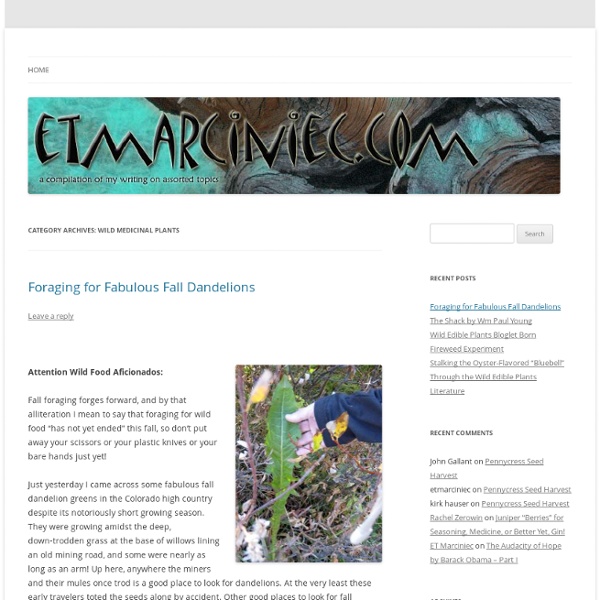Free Wild Plant Identification eCourse
You are out in the forest and looking at the glorious plant life surrounding you. Whether you are a beginner and have never identified one plant, or a Botany professor at a university, you might appreciate this refreshingly simple approach to plant identification. I remember lovingly (and sometimes screamingly) that my college classes in Systematic Botany required me to become acquainted with that local Washington Flora that we plant dorks call “Hitchcock and Cronquist”. In addition, my observation skills as an ethnobotanist were refined , foraging for wild foods, fibers and medicine. What will I need? A combination of actual need for sustenance, curiosity and simple observation skills are almost all you need to start with plant identification. Wherever you are in this journey, the following activities and tips will add some elegant tools to your already blooming botanical basket. Meet a Plant Approach the plant of your choice and find a place to start.
Sagittarius
Wildcrafting.net: Foraging Database, Edible & Medicinal Plants
Maat
The earliest surviving records indicating Maat is the norm for nature and society, in this world and the next, were recorded during the Old Kingdom, the earliest substantial surviving examples being found in the Pyramid Texts of Unas (ca. 2375 BCE and 2345 BCE).[2] Later, as a goddess in other traditions of the Egyptian pantheon, where most goddesses were paired with a male aspect, her masculine counterpart was Thoth and their attributes are the same. After the rise of Ra they were depicted together in the Solar Barque. After her role in creation and continuously preventing the universe from returning to chaos, her primary role in Egyptian mythology dealt with the weighing of souls that took place in the underworld, Duat.[3] Her feather was the measure that determined whether the souls (considered to reside in the heart) of the departed would reach the paradise of afterlife successfully. Maat as a principle[edit] Winged Maat Maat and the law[edit] Maat wearing feather of truth See also[edit]
Wild Edibles: How to Eat Common Milkweed
Disclaimer: Eating certain wild plants can be deadly!! Be certain to consult a professional (or a really good field guide) in order to positively identify this plant before trying this for yourself. The owners of this site will not be held responsible for any lapses in judgment or stupidity when handling or consuming wild plants. Milkweed is one of those plants that I have fond memories for. In my late teens and early 20s, when I was big into practicing wilderness survival skills, I would often use the outer fibers on the stalk to make a serviceable cordage (I still enjoy doing this) and I learned to use the seed down but it wasn’t until I was a bit older that I learned how wonderful this plant is as a wild edible. I always knew it was edible, however I never bothered trying it since all the books I had read on the plant indicated that to render this plant palatable, it required multiple (three or more) boilings in order to remove the toxins and “bitter” taste. How to Eat Common Milkweed
100 Ways to Repurpose Everything
Think this title is a tall order? Well, you’re in for a post of epic eco-tastic proportions. So epic that you may need to give your computer or mobile device an extra moment to load all of our pretty pictures. Seeing as we love to repurpose just about anything under the sun, we’re celebrating Earth Day by serving up 100 of our favorite ways to upcycle, reuse, and transform everyday materials into creative new things to wear, hang on the wall, and give to friends. 1. 2. 3. 4. 5. 6. 7. 8. 9. 10. 11. 12. 13. 14. 15. 16. 17. 18. 19. 20. 21. 22. 23. 24. 25. 26. 27. 28. 29. 30. 31. 32. 33. 34. 35. 36. 37. 38. 39. 40. 41. 42. 43. 44. 45. 46. 47. 48. 49. 50. 51. 52. 53. 54. 55. 56. 57. 58. 59. 60. 61.
Cold-hearted Cattail Salads | Wild Food Girl
Cattail shoots ready for harvest outside Ithaca, NY, June 2013. After tugging a few from the pond, I went for the easier-to-harvest shoots in a dry area on the pond’s edge. The renowned forager and writer Euell Gibbons called cattails “the supermarket of the swamps,” and from that moniker other nicknames have emerged, among them “the Walmart of the swamps.” Although evoking Walmart doesn’t help me to connect with my joy for wild plants, the sobriquets are so given because of all the different plant food cattails (Typha spp.) yield—from the shoots (aka hearts or leaf cores) and flower spikes* to cattail pollen as flour, along with several underground parts, among which the rhizomes require a bit of processing to separate the edible starches. It is also often the case that cattails are quite plentiful where they occur, making them a good choice for a sustainable wild harvest. Perhaps easiest to collect and process are the shoots or hearts, also known as “Cossack asparagus.” Lookalikes
untitled
Identify That Plant: Master The Skill Of Plant Identification
my winter days



